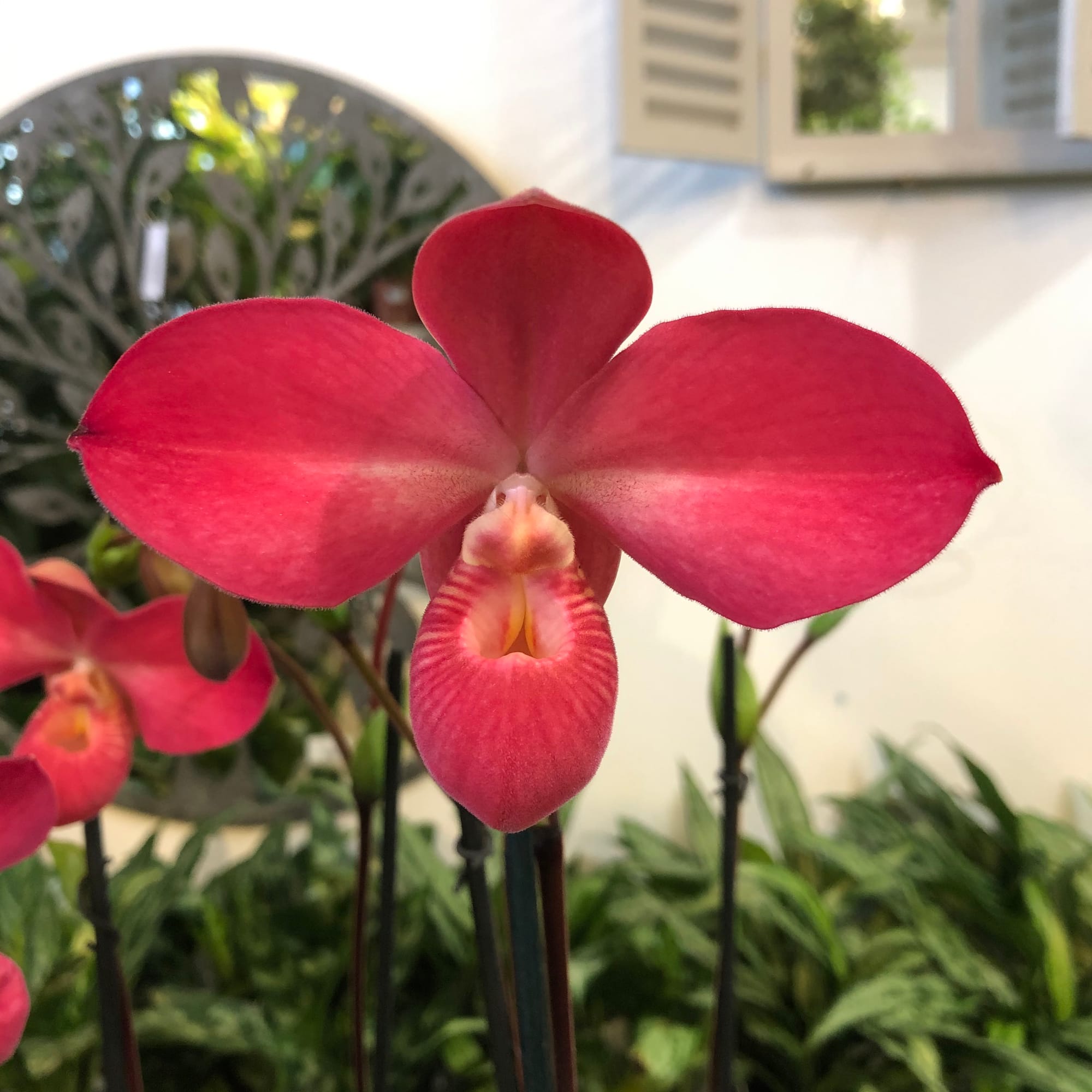
Phragmipedium 'Fritz Schomburg'
Contents
- Top Tips
- Location, Water, Humidity & Fertilisation
- Dormancy Care & Annual Flowers
- Common Issues
- Origins, Temperature, Propagation, Repotting & Toxicity.
Need the answer to a specific plant query? Book a 1-to-1 video call with THE HOUSEPLANT DOCTOR™, the website's friendly author, to overcome and address your niggling problem! Available on iMessage, WhatsApp, Facebook Messenger & more.
Top Tips & Info
- Care Difficulty - Easy to Moderate
- Phragmipediums (often abbreviated as 'Phrags') prefer to be sat in a bright, indirect location away from the sunlight or operating radiators.
- Keep the soil/bark evenly moist, allowing the top third to dry out in between hydrations. Reduce the number of waters slightly in the autumn and winter to reinforce its dormancy period.
- Avoid persistent droughts and the use of cold water, especially while it's in bloom.
- Provide reliable (steady) humidity via a pebble tray to promote longer-lasting flowers.
- Avoid misting the flowers for the prevention of Botrytis Petal Blight.
- Monthly supplements of an Orchid-labelled fertiliser, all year round.
- Read 'Dormancy Care & Annual Blooms' further down to learn about achieving yearly shows.
- Repot every two to four years, using a mix of houseplant compost and Orchid Bark. Remember only to repot your specimen once the flowers have elapsed; 'Transplant Shock' is caused when the roots are over-touched, which may result in sudden flower loss.
Location & Light - 🔸🔸
Direct sunlight during the spring and summer should be avoided at all costs due to the heightened chance of dehydration and sun-scorch. In the wild, Phrags grow terrestrially on the jungle floor (sometimes on rocks) and therefore are protected by the tree's canopy. Move the plant into a brighter location with a splash of morning or evening sunlight for an hour, once the autumn and winter months arrive. The ideal location would be within a few metres of a north or west-facing window, or in a setting that a newspaper can be read without the use of artificial lighting. Those situated in darker areas will be at risk of root rot, along with the minimal chance of another bloom.
Water - 🔸🔸
Keep the soil/bark evenly moist, allowing the top third to dry out in between irrigations. As Phrags lack a pseudobulb, there isn't a storage organ to hold vital nutrients and water in times of stress. Periods of droughts will significantly disturb the blooming process, with sudden flower or bud loss being the biggest issue among growers. The application of cold water must also be avoided, as it'll shock the roots and potentially lead to weak growth and sudden flower loss. Under-watering symptoms include flower loss, pale or flaccid leaves, stunted growth and a gradual decline in health. Never allow the intense sun or forgetfulness to take over, as both will result in a weakened specimen. Over-watering symptoms include lower yellowing of leaves, a rapidly declining stem, flower loss and a rotten base. In essence, these issues are commonly down to either too much soil moisture, an incorrect soil medium, too little light, or foliage that has allowed to remain saturated for long periods.
Read More - Common Orchid Diseases
Humidity - 🔸🔸🔸
Providing reliable humidity is at the forefront of a happy Phragmipedium. Browning leaf-tips are the result of dry air, commonly caused by operating radiators in the colder months. Place the plant on a pebble tray to increase the surrounding air moisture, avoiding the use of misters. Any excess moisture that remains in the cubbyholes or flowers will entice botrytis, southern blight or powdery mildew to the table.
The use of artificial humidity methods aren't needed in the summer but will reap benefits to those who use them all year round.
Fertilisation - 🔸🔸
Orchid Feeds are tailored for all members of the Orchidacæ Family, that can be in the guise of drip feeders or dilatable bottles. Although fertilisers are most suited for this genus, 'houseplant'-labelled alternatives are still accepted.
For those who are seeking further tips on fertilisation, use a potassium-based Orchid feed during the budding and blooming process. Once the final flower elapses, revert to a nitrogen and phosphorus-based feed to aid the plant's foliar and root development.
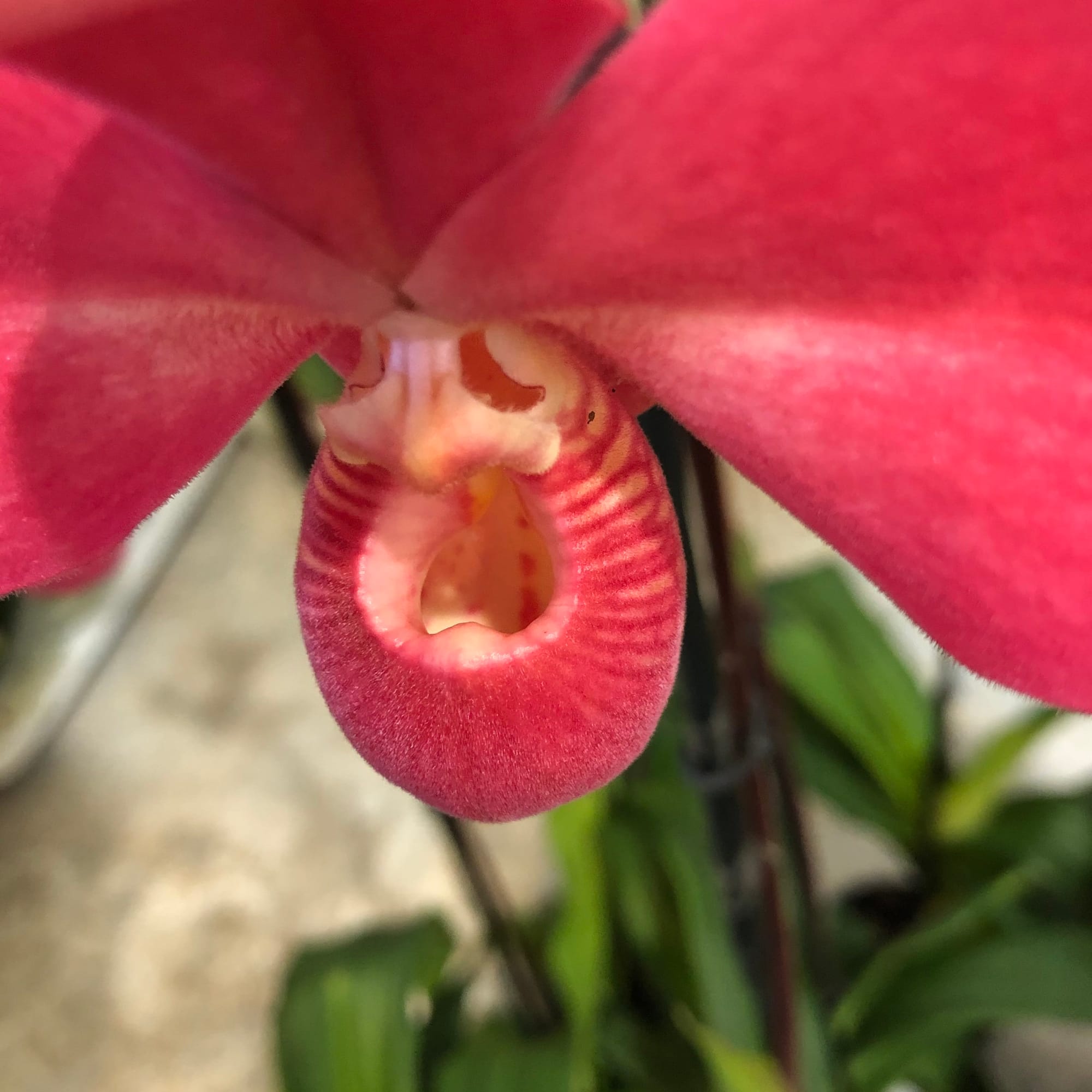 The name, Phragmipedium, gets its name from the Greek words phragma and pedium, which translates to 'division' and 'slippers' that refers to the pouch-like labella.
The name, Phragmipedium, gets its name from the Greek words phragma and pedium, which translates to 'division' and 'slippers' that refers to the pouch-like labella.
Dormancy Care & Annual Flowers
Trying to achieve a bloom isn't the hardest of tasks, with those who have a cooler room without artificial light at night being on the upper-hand. Keep the roots pot-bound to add further stress onto the specimen, which in turn will significantly heighten the chance of flowering. Blooms will generally appear in the late spring but may occur at any given time.
The following steps should be performed from autumn through until early spring, during their dormancy.
Sunlight & Location
Be sure to provide a bright location with little to no direct sunlight. Although the winter rays won't necessarily hurt the plant, be careful not to fall in the trap of sun-scorch and severe dehydration.
For it to fully become seasoned, avoid the use of artificial lighting or locations that boast temperatures higher than 18℃ (64℉).
Hydration
Reduce irrigations so that half of the soil becomes dry and remember not to apply cold water into the soil as it could shock the roots. Reduce the number of waters considerably in comparison to that in the spring and summer months.
Occasional Feeds
Whilst in bloom, use an Orchid feed to provide a nourishment of potassium at monthly intervals. The use of fertiliser is only necessary from when the first flower spike emerges from the base.
Reduce Everything
This one is to remind you that everything needs to be reduced - especially the temperature.
Temperature
Provide a warm location in the growing period, before reducing it down to 15° - 18℃ (59° - 64℉) in the latter stages of summer. The drop in temperature should ideally last until the inflorescence finishes blooming, although it can still be transferred into the main house as long as it sits on a pebble tray. You'll be at a big disadvantage if the ambient temperature is kept constant throughout the year, as Phrags will only respond with flowers in the spring when exposed to cooler temperatures in the winter.
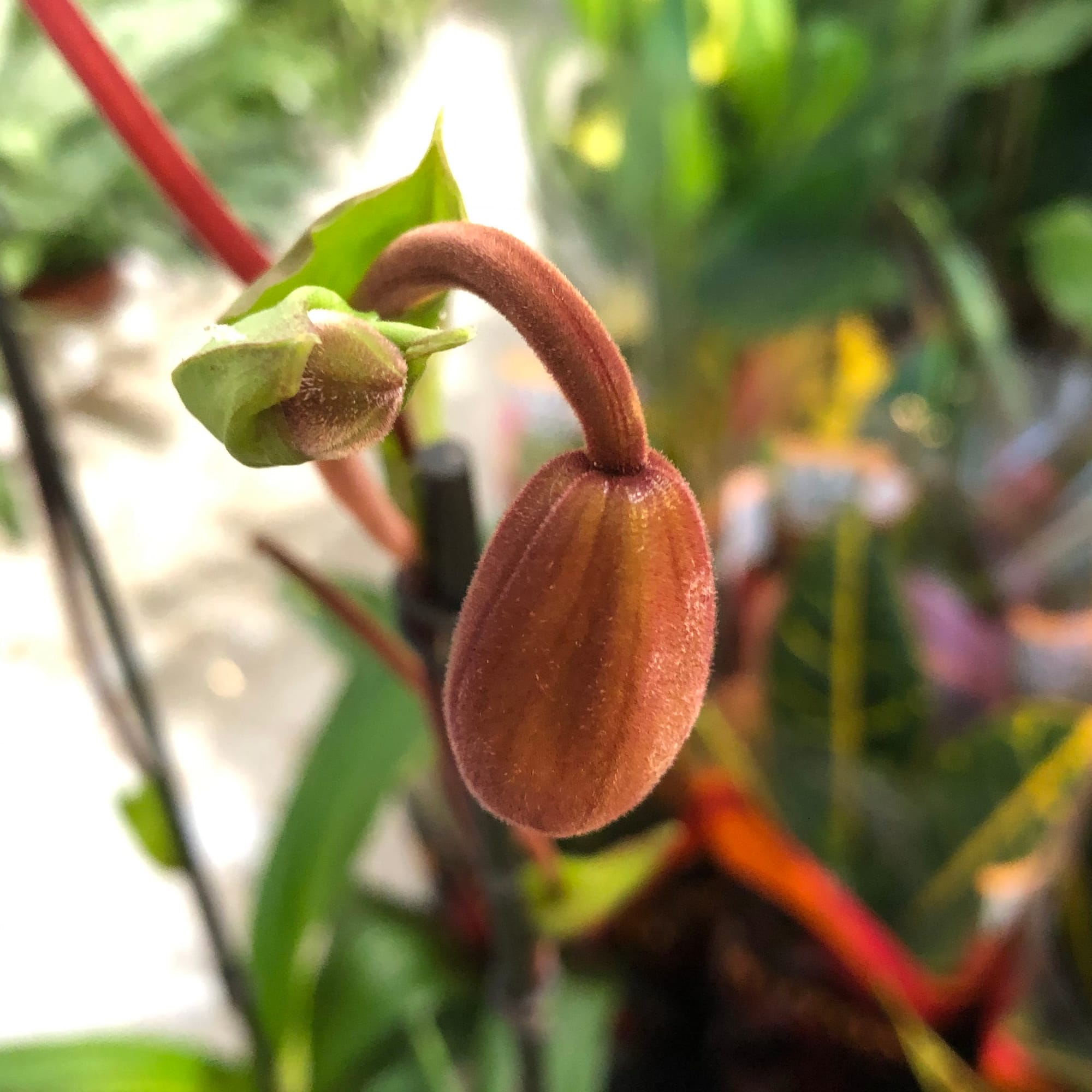 The sudden loss of flower-buds could be a sign of environmental shock when a specimen is relocated into a new location. Maintain evenly moist soil, provide good humidity and indirect light to help the plant develop new buds.
The sudden loss of flower-buds could be a sign of environmental shock when a specimen is relocated into a new location. Maintain evenly moist soil, provide good humidity and indirect light to help the plant develop new buds.
Common Issues with Phragmipedium
A lack of flowers is caused by an insufficient dormancy period, where the temperatures are kept more or less the same over the year. Reduce this by a couple of degrees over the autumn and winter months, along with fewer irrigations; scroll up to the previous section to learn more about stimulating flower spikes.
A sudden loss of flowers with a yellowed stalk is a sign of prolonged droughts. Especially during the flowering process, near-continuous moist bark is mandatory for extended blooms; allow the roots to turn a green-greyish colour in between irrigations.
Short-lived flowers could be the product of low humidity. Place the Orchid on a humidity/pebble tray, keeping the reservoir topped up with water throughout the winter - artificial humidifiers aren't necessary for the summer months. Other ways to increase the surrounding moisture are to situate it in a bathroom or at least three metres away from an operating heat source. Never mist the flowers due to the high risk of developing botrytis petal blight.
Root rot is another key issue with Phrags. Roots will start to turn brown and mushy that can be observed through the transparent pot, causing fungal problems if left untreated. The disease is commonly caused by either moisture in between irrigations, or water-logging, usually accompanied by a dark location. Click on this link to learn about how to address this issue.
Large quantities of aerial roots that cascade over the pot may show signs of root rot or pot-boundness, but is otherwise wholly natural. Once the flowers have fully elapsed, take the plant out of its plastic pot and remove any brown, mushy submerged roots. It's important NOT to over-touch the healthy white roots as this will lead to transplant shock and death. Use a 50/50 mixture of 'houseplant compost and an Orchid Bark for its potting-mix. Repot into a slightly bigger container that's two inches wider and deeper than the original, and angle a few of the airborne roots into the soil, too. If there are a couple of roots that are still airborne, either direct them face-down into the bark or allow them to carry on cascading over the pot. Be sure to mist the aerial roots while watering the bark to ensure sufficient hydration from then-on. If they begin to split, it's the result of too little water/humidity or overexposure to the sun. Remove when they fully yellow over.
Crown rot is another big issue among growers. Splashing the foliage each time you come to water, an Orchid will significantly increase the chance of susceptibility. For those who have this issue, remove the affected leaves and blow the excess moisture from its crown. If the whole base has softened over, it's game over.
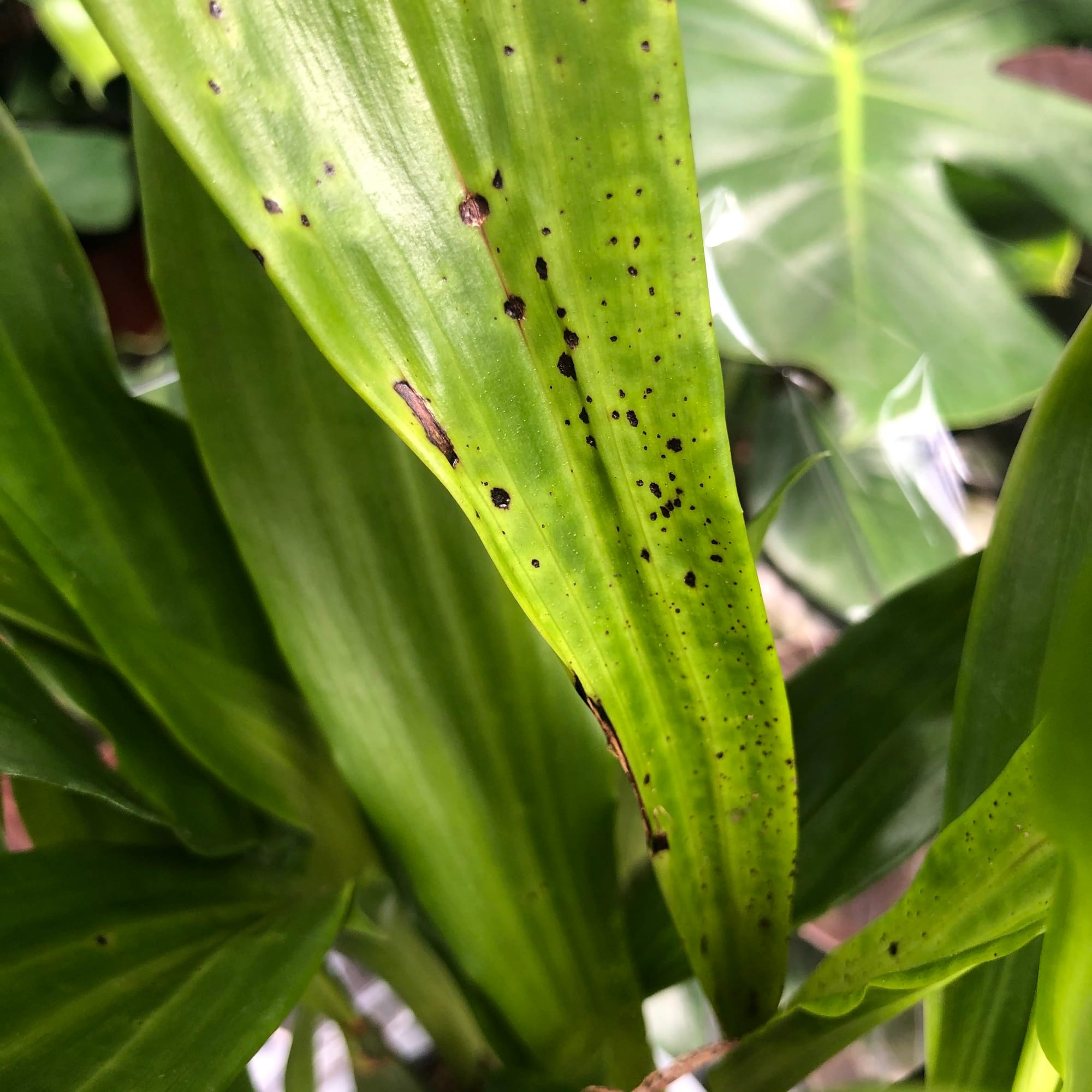 There are several species of Leaf-Spot Disease, (Graphiola, Botrytis, Anthracnose & Cercospora) with all operating similarly. Fungi spores will land on the leaf's surface and will slowly develop along with the plant. Unfortunately, as there aren't any products that'll address the issue head-on, you can only remove the affected areas and regularly wash the leaves to limit the spread. Keep the plant away from unaffected specimens for at least a month after the last symptom.
There are several species of Leaf-Spot Disease, (Graphiola, Botrytis, Anthracnose & Cercospora) with all operating similarly. Fungi spores will land on the leaf's surface and will slowly develop along with the plant. Unfortunately, as there aren't any products that'll address the issue head-on, you can only remove the affected areas and regularly wash the leaves to limit the spread. Keep the plant away from unaffected specimens for at least a month after the last symptom.
Botrytis Petal Blights are small spots or patches that'll develop on the flowers' bodies, usually caused by misting or an over-humid location with poor air circulation. Remove infected flowers or the complete stalk by using sterile utensils to put a stop the airborne disease. Improve the air circulation and move to a possible brighter location with no direct sunlight. Be careful not to saturate the flowers from there on, and regularly inspect to see if it has spread. Click here for more info - Common Orchid Diseases
Pests such as Mealybugs are a common issue with Phrags. Small white cottony webs, along with some shell-like bugs will develop along the cubbyholes of the flowers and foliage. Infestations must be dealt with immediately, as the spread and damage of these pests are immense - yellowing leaves, sudden flower loss and gooey sticky patches are among the common symptoms. Click on the link above to learn more.
Yellowing leaves with small black patches or blotches are caused by coldness. Although this could just be a simple case of too low temperatures, other factors like draughts or a leaf resting against a cold window could also be at fault.
Always use lukewarm water, and if you choose to use tap water, allow it to stand for at least 24hrs before application. Orchids tend to be quite sensitive to temperature change, so pouring cold tap water immediately into the pot will not only damage your roots but could even cause yellowed foliage, sudden flower loss and stunted growth.
Origins
Robert Allen Rolfe first described Phramipedium in 1896, using the Greek words phragma and pedium, that translates to 'division' and 'slippers'. Its name, which was originally penned with an 'L' (Phragmipedilum), refers to the pouch-shaped labellum which attracts airborne pollinators. It is a characteristic featured on many Orchids part of Cypripedioideæ.
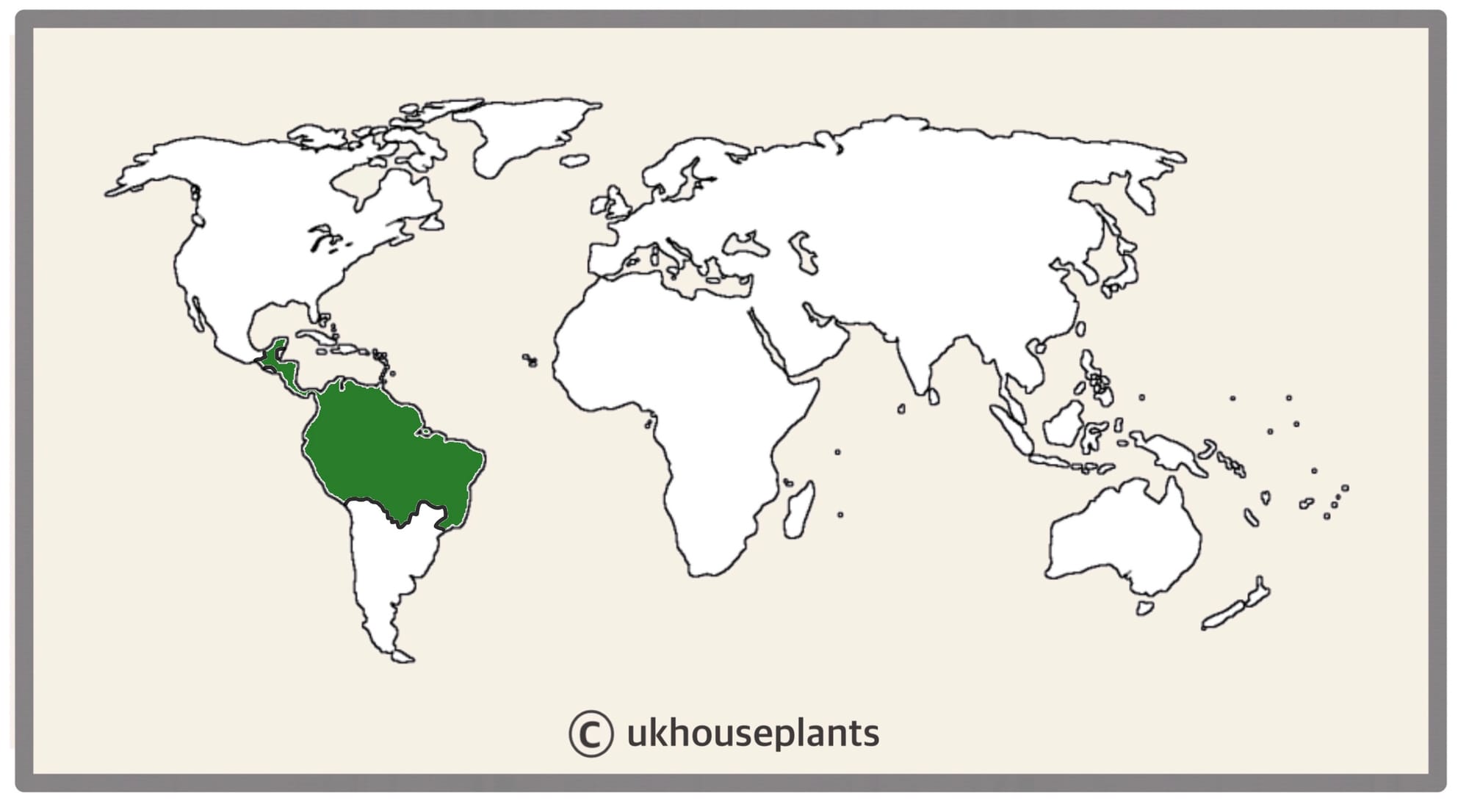 The Distribution of Phragmipedium
The Distribution of Phragmipedium
Temperature
10° - 27°C (50° - 80°F)
H1b (Hardiness Zone 12) - Can be grown outdoors during the summer in a sheltered location with temperatures above 12℃ (54℉), but is fine to remain indoors, too. If you decide to bring this plant outdoors, don't allow it to endure any direct sunlight per day as it may result in sun-scorch and dehydration. Regularly keep an eye out for pests, especially when re-introducing it back indoors.
Spread
Up to 0.8m in height & 0.4m in width, with maturity being achieved in around 5 - 8 years. Between one and three new leaves will grow per season, along with several new basal offsets, depending on its cultivation and environment.
Pruning & Maintenance
Remove yellow or dying leaves, and plant debris to encourage better-growing conditions. While pruning, always use clean scissors or shears to reduce the chance of bacterial and fungal diseases. Never cut through yellowed tissue as this may cause further damage in the likes of diseases or bacterial infections. Remember to make clean incisions as too-damaged wounds may shock the plant, causing weakened growth and a decline in health.
Do not remove the shaft once the flowers elapse; small 'Keiki' offsets may develop on the nodes (behind the leaves) in due course. Scroll down to 'Propagation' to learn more about this fantastic phenomenon!
Propagation
Via Seed, Basal Offshoots & 'Keiki' Cuttings.
Seed Propagation (Difficult) - Obtaining and sowing of seeds from your Orchid is both difficult and near-impossible without the correct equipment. While using a seaweed-based agar, provide bottom heat with a warm location that's above 18°C (54°F). Avoid direct sunlight with persistent droughts for best results. Germination may take up to six months, so don't discard any unsuccessful seeds until this threshold has been surpassed. Remove the bag once the seedlings produce its second leaf and then split them up into their own 5cm pots.
Basal Offshoots Easy) - It's best to divide between spring and summer with plantlets that are at least a third of the size of the mother plant with several developed roots; have a look at the image below to see what a basal offshoot looks like. Take the plant out of its pot and place your fingers in between the two; soil may have to be removed to get a better grip. While placing your hand close to the nodal junction, gently push the pup downwards and keep supporting the mother plant - you should hear a snap. Cautiously separate both the mother plant and pup's roots systems, keeping great empathise in keeping the roots intact and undamaged. Place the new plantlet in Orchid Bark, much similar to the original soil, and maintain the same care routines. Be sure not to use a pot that is too big; a ratio of roots-soil that much leans towards the latter will cause root rot.
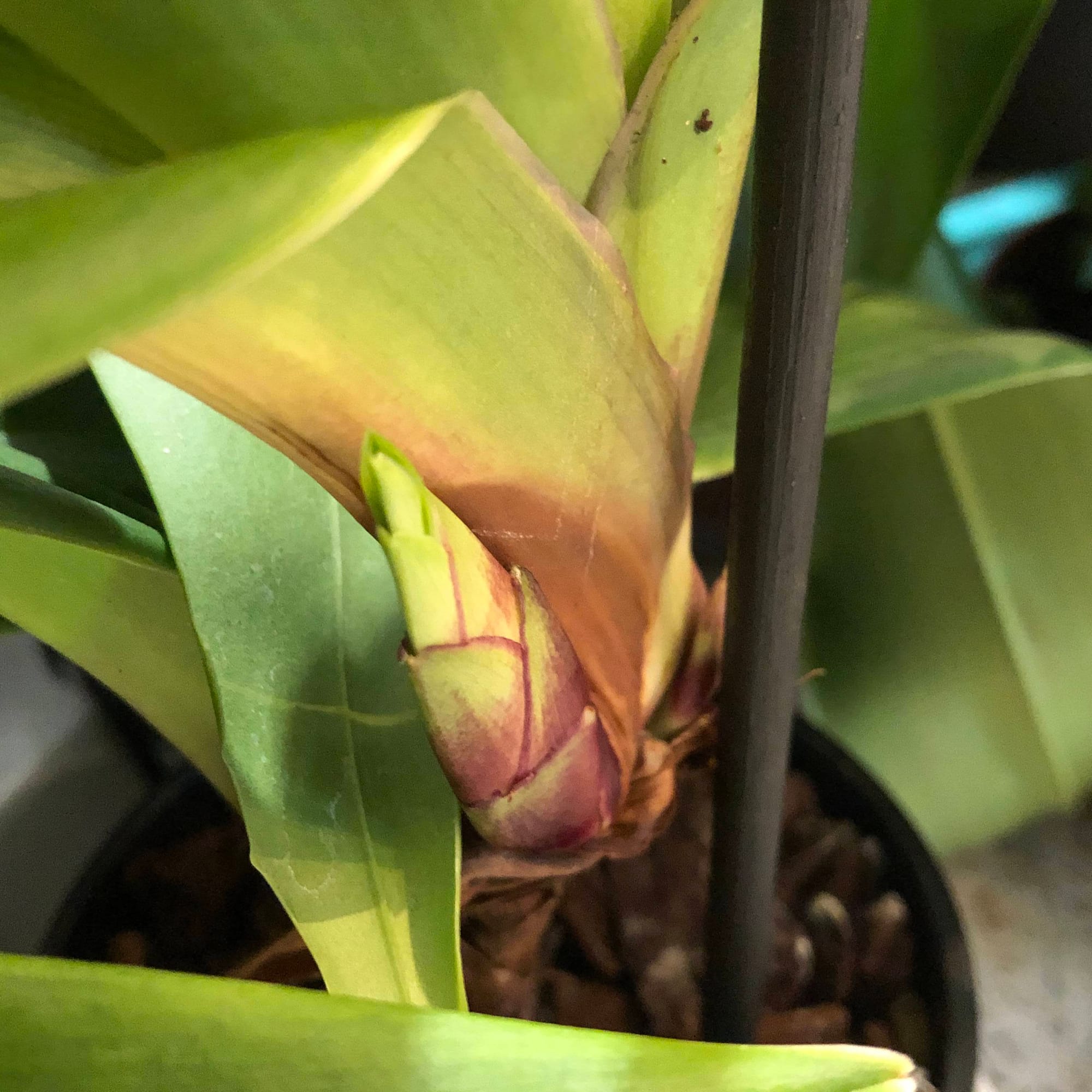 An immature basal offset that can be propagated in a few month's time.
An immature basal offset that can be propagated in a few month's time.
'Keiki' Cuttings (Easy) - Small offsets, or 'Keiki's', will develop along the mother plant's flower stalks on various non-flowering nodes. Once the roots are more than 3cm (2 inches) in length, cut the Keiki off, keeping a small section of stem either side to the joining. Pot the plantlet's bottom half into Orchid Bark, avoiding the risk of over-potting it, which could result in rotten foliage. Immediately give it a splash of water, preventing excess moisture from settling on the foliage or cubbyholes. In terms of cultivation, provide a bright indirect setting with good air circulation and a humidity tray.
Flowers
Flowers can last up to three or four months and can bloom at any time, most commonly during the months of spring and summer. Its flowers will develop along a long shaft, housing between one to three flowers. The best way to tempt this Orchid into flowering is by reducing the temperature and water in the autumnal months; have a read of 'Dormancy Period & Annual Flowers' above for more information.
Repotting
Infrequent repots will restrict its growth for a potential bloom. They'll be under threat by the challenging environment, and as they'll potentially die (so they think), a flower shaft will be produced to pass on its genes to the next generation.
Repot every three years in the spring (& when not in bloom), using Orchid Bark with the next sized pot. Hydrate the plant 24hrs before the tinkering with the roots to prevent the risk of transplant shock. Phrags are better potbound for a number of reasons, including the prevention of root rot or transplant shock, and to restrict its growth for a better chance of flowering. So, with this in mind, we'd recommend repotting them as infrequently as possible. Click here for a detailed step-by-step guide on transplantation, or via this link to learn about repotting with root rot.
Pests & Diseases
Keep an eye out for spider mites, mealybugs, scale, slugs & vine weevils, that'll locate themselves in the foliage's cubbyholes or flowers, with the exception of the latter in soil. Common diseases include collar rot, root rot, Botrytis Petal Blight, Guignardia, black rot & anthracnose. Please be aware that applying general pesticide or spray could damage both the plant's leaves and flowers over time if used incorrectly. If pests or diseases are an issue with your Orchid, be sure to click these links for more information. Identifying Common Houseplant Pests or Common Orchid Diseases.
Toxicity
Not known to be poisonous by the consumption of pets and humans. If high quantities are eaten, it may result in vomiting, nausea and a loss of appetite.
Retail Locations
Blue Diamond may stock Phrags from time to time, but Online Stores seem to be the way forward for purchases.
Book a 1-to-1 Call with THE HOUSEPLANT DOCTOR™
If you need further advice with your houseplants, book an advice call with ukhouseplants' friendly and expert writer today! This can be done via a video or audio call on most apps, including Facebook, FaceTime & Skype. A ten-minute call costs £5.99 (US$7), or £15.99 for thirty minutes. You can ask multiple questions, including queries on plants, pests, terrariums, repotting advice and anything in between. Please consider supporting this service to keep ukhouseplants thriving!